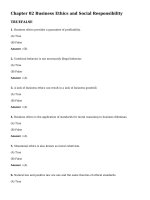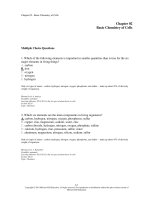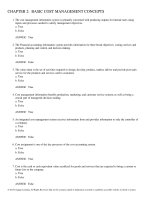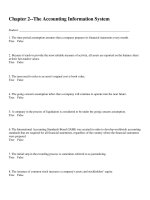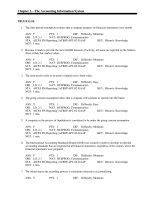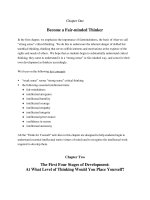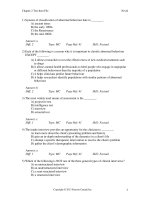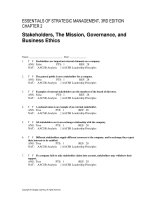Survey of accounting 3rd edition edmonds test bank
Bạn đang xem bản rút gọn của tài liệu. Xem và tải ngay bản đầy đủ của tài liệu tại đây (4.89 MB, 88 trang )
02
Student: ___________________________________________________________________________
1.
Osborn Company provided services to a customer on account. Which of the following represents the
effect of this transaction on the financial statements?
A.
B.
C.
D.
2.
Choice A
Choice B
Choice C
Choice D
ABC Company experienced an accounting event that affected its financial statements as indicated below:
Which of the following accounting events could have caused these effects on ABC's financial statements?
A.
B.
C.
D.
earned revenue on account
purchased equipment on account
provided services to customers for cash
recognized accrued salaries owed to employees
3.
Which of the following transactions does not involve an accrual?
A. recording revenue that has been earned but not yet received
B. recording interest expense incurred but not yet paid
C. recording salary expense incurred but not yet paid
D. recording the pre-payment of two year's worth of insurance
4.
The Redding Company recorded salaries earned by employees but not yet paid. Which of the following
represents the effect of this transaction on the financial statements?
A.
B.
C.
D.
Choice A
Choice B
Choice C
Choice D
5.
The term "realization" refers to which of the following?
A. the closing of an account
B. the collection of cash from sale of goods or services
C. the earning of revenue
D. the correction of an error
6.
Which of the following events involves an accrual?
A. a cash payment received from a customer before services are provided
B. supplies purchased with cash but not yet used
C. interest earned but not received
D. A and C
7.
The entry to recognize salary expense incurred but not yet paid involves which of the following?
A. an increase in liabilities
B. an increase in assets
C. a decrease in assets
D. an increase in equity
8.
The Greenwood Company purchased equipment costing $900. Greenwood paid $400 in cash and agreed
to pay the remaining amount in thirty days. As a result of this transaction:
A. total assets increased by $400.
B. liabilities increased by $500.
C. total assets increased by $900.
D. both B and C.
9.
Sefcik Company purchased supplies on account. Which of the following choices accurately reflects how
this event would affect the company's financial statements?
A.
B.
C.
D.
Choice A
Choice B
Choice C
Choice D
10. At the end of the accounting period, Sefcik Company made an adjusting entry for supplies consumed.
Which of the following choices reflects how this event would affect the company's financial statements?
A.
B.
C.
D.
Choice A
Choice B
Choice C
Choice D
11. Stahl Company paid $7,800 on May 1, 2012 for insurance coverage for a one year period beginning
that date. The adjusting entry required to recognize insurance expense on December 31, 2012 would have
what effect on the financial statements?
A.
B.
C.
D.
Choice A
Choice B
Choice C
Choice D
12. Recording accrued salary expense at the end of an accounting period causes an increase in Salaries
Expense and
A. an increase in a liability.
B. a decrease in an asset.
C. an increase in an equity account.
D. none of these.
13. Which of the following transactions involves a deferral?
A. recording the prepayment of three months' rent
B. recording the interest earned (but not received) on a certificate of deposit
C. recording interest accrued on a note payable
D. recording salaries of employees earned but not yet paid
14. Which of the following does not involve a deferral?
A. receipt of advance fees from clients
B. recording salaries of employees earned but not yet paid
C. payment of six months' rent
D. purchase of supplies on account
15. The adjustment to record the completion of services for which clients had paid in advance would involve
which of the following?
A. a decrease in assets and an increase in equity
B. a decrease in liabilities and an increase in equity
C. an increase in assets and a decrease in liabilities
D. an increase in liabilities and a decrease in equity
16. If a company purchases supplies on account, this transaction would cause
A. total assets to decrease.
B. liabilities to increase.
C. equity to decrease.
D. Retained Earnings to increase.
17. On May 1, 2012, Perez Company paid $12,000 rent for a one year lease on equipment it uses in its
operations. The adjusting entry at the end of the year
A. decreases assets and stockholders' equity.
B. decreases assets and liabilities.
C. increases an expense and decreases a liability.
D. is not required.
18. The following selected account balances were drawn from the 2012 balance sheet and income statement
of Fultz Company:
Based on the above information, what is the balance of Common Stock for Fultz Company?
A. $750
B. $1,550
C. $1,050
D. $2,050
19. Dale Company purchased land costing $2,400 by paying cash. The company earned $2,000 revenue on
account and incurred $1,100 of operating expenses on account. As a result of these transactions:
A. total assets increased by $2,400.
B. liabilities increased by $1,100.
C. total assets increased by $5,400.
D. both A and B.
20. Bloomfield Company issued stock for $30,000 cash on January 20, 2012. During 2012, the company
recorded revenue on account of $12,000 and expenses on account of $5,500. Bloomfield received $8,200
cash from accounts receivable and paid $4,500 on the accounts payable. The company also purchased
land for $5,000 cash. The beginning cash balance was zero. Based on this information, the amount of
cash at the end of the year is:
A. $31,500
B. $22,974
C. $29,100
D. $28,700
21. Nikonowicz Enterprises experienced the following events during 2012, its first year in operation:
The business acquired $10,000 cash by issuing common stock to investors.
The business purchased land for $6,000 cash.
Services were provided to customers for $8,000 cash.
Services were provided to customers for $3,000 on account.
Operating expenses of $5,000 were incurred and paid in cash.
Operating expenses of $2,000 were incurred on account.
A dividend of $1,000 was paid to the owners of Nikonowicz Enterprises.
Based on this information, the amount of retained earnings as of December 31, 2012, was
A. $1,000.
B. $3,000.
C. $5,000.
D. $11,000.
22. Jaycox Company received $1,000 cash from the issue of stock on January 1, 2012. During 2012 the
Jaycox Company earned $3,500 of revenue on account. The company collected $2,400 cash from
accounts receivable and paid $3,000 cash for operating expenses. Based on this information alone:
A. total assets increased by $1,500.
B. total assets decreased by $3,500.
C. total assets increased by $2,400.
D. total assets did not change.
23. The following accounts and balances were drawn from the records of Schultz Company:
Based on this information, the amount of retained earnings was:
A. $9,500
B. $18,500
C. $15,500
D. $22,500
Nez Company provided services for $7,500 cash during the 2012 accounting period. Nez incurred $6,000
expenses on account during 2012, and by the end of the year, $3,000 of that amount had been paid
with cash. Nez paid dividends of $900 to stockholders during the year. Assume that these are the only
accounting events that affected Nez during the 2012 accounting period.
24. What was the amount of Nez's net income for 2012?
A. $1,500
B. $600
C. $4,500
D. $3,600
25. What was Nez's cash flow from operating activities for 2012?
A. $3,600
B. $1,500
C. $4,500
D. $600
For Grace Company, revenue on account amounted to $5,000. Cash collections of accounts receivable
amounted to $2,300. Expenses incurred on account were $2,100. Cash paid on accounts payable was
$1,950.
26. Grace's net income was:
A. $200.
B. $350.
C. $3,050.
D. $2,900.
27. Grace's cash flow from operating activities was:
A. $200.
B. $300.
C. $350.
D. $2,900.
The following accounts and balances were drawn from the records of Rayburn Company on December
31, 2012:
28. Total assets on the December 31, 2012 balance sheet amounted to
A. $2,650.
B. $3,450.
C. $1,800.
D. $3,150.
29. The amount of net income shown on the December 31, 2012 income statement would amount to:
A. $550.
B. $800.
C. $50.
D. $250.
30. Which of the following accounts would not appear on a balance sheet?
A. Equipment
B. Interest Payable
C. Interest Revenue
D. Retained Earnings
31. Which of the following would be included in the "cash flows from investing activities" section of the
statement of cash flows?
A. Borrowed $10,000 from a local bank.
B. Paid $1,000 of expenses with cash.
C. Sold land for cash.
D. Issued common stock for cash.
32. Which of the following would be included in the "cash flows from financing activities" section of the
statement of cash flows?
A. Collected cash from accounts receivable.
B. Loaned cash to another company.
C. Paid cash dividend to stockholders.
D. Purchased insurance.
33. Recognition of revenue may result in which of the following?
A. a decrease in assets.
B. an increase in assets.
C. an increase in liabilities.
D. a decrease in expenses.
34. Which of the following financial statement elements is closed at the end of an accounting cycle?
A. Liabilities
B. Equity
C. Revenues
D. Assets
35. Which of the following accounts would not be closed at the end of an accounting cycle?
A. Common Stock
B. Revenue
C. Dividends
D. Salaries Expense
36. The matching concept refers to the "matching" of:
A. expenses and liabilities
B. expenses and revenues
C. assets and equity
D. assets and liabilities
37. The result of the matching process is reported on which financial statement?
A. Balance Sheet
B. Income Statement
C. Statement of Changes in Stockholders' Equity
D. Statement of Cash Flows
38. Expenses that are matched with the period in which they are incurred are frequently called:
A. period costs.
B. matched expenses.
C. market expenses.
D. working costs.
39. Which of the following lists represents the correct sequence of stages in an accounting cycle?
A. record transactions, prepare statements, adjust accounts, close temporary accounts
B. prepare statements, close temporary accounts, record transactions, adjust accounts
C. close temporary accounts, record transactions, prepare statements, adjust accounts
D. record transactions, adjust accounts, prepare statements, close temporary accounts
40. The purpose of the accrual basis of accounting is to:
A. report revenue when received.
B. improve the matching of revenue and expense in the proper period.
C. report expenses when cash disbursements are made.
D. improve the company's earnings per share.
41. Which of the following accounts is a permanent account (an account that is not closed)?
A. Rent Expense
B. Service Revenue
C. Dividends
D. Prepaid Insurance
42. Which of the following accounts is a temporary account?
A. Prepaid Insurance
B. Unearned Subscriptions Revenue
C. Retained Earnings
D. Subscription Revenue
43. The conservatism principle
A. is primarily concerned with correctly valuing a business's assets.
B. matches assets and liabilities.
C. requires accountants to choose the accounting treatment that minimizes net income.
D. is concerned with matching expenses with revenues.
44. Which of the following would cause net income on the accrual basis to be different than (either higher or
lower than) cash provided by operating activities on the statement of cash flows?
A. acquiring $10,000 cash from the owners
B. incurring operating expenses on account
C. providing services to a customer for cash
D. purchasing land for cash
45. Harrison and Sons is a law firm. On September 1, 2012, Harrison contracted to provide 12 months
of legal services to a client. On that date, Harrison collected a $36,000 retainer and began providing
services. How much revenue would Harrison report from that client for the year ending December 31,
2012?
A. $36,000
B. $12,000
C. $9,000
D. $15,000
The Blumer Company entered into the following transactions during 2012:
1. The company was started with $22,000 of common stock issued to investors for cash.
2. On July 1, the company purchased land that cost $15,500 cash.
3. There were $700 of supplies purchased on account.
4. Sales on account amounted to $9,500.
5. Cash collections of receivables were $5,500.
6. On October 1, 2012, the company paid $3,600 in advance for a 12-month insurance policy that became
effective on October 1.
7. Supplies on hand as of December 31, 2010 amounted to $225.
46. The adjusting entry necessary to record the supplies expense would result in a:
A. $700 increase in assets and liabilities.
B. $700 decrease in assets and equity.
C. $475 decrease in assets and equity.
D. $475 increase in assets and liabilities.
47. The amount of insurance expense reported on the income statement for 2012 would be:
A. $900.
B. $2,400.
C. $300.
D. $600.
48. The amount of cash flow from operating activities would be:
A. $1,900.
B. $8,400.
C. $3,100.
D. $5,400.
49. The amount of total liabilities appearing on the December 31, 2012 balance sheet would be:
A. $3,600.
B. $4,000.
C. $475.
D. $700.
LeMars Company signed a three year contract to perform consulting services for a local manufacturer on
September 1, 2012. LeMars received $48,000 cash as an advance payment for these services and agreed
the work would begin immediately.
50. The amounts of revenue that would appear on the 2012 and 2013 income statements would be:
A. $16,000/$16,000.
B. $48,000/$-0-.
C. $5,333/$16,000.
D. $5,833/$29,187.
51. The amounts of cash flow that would be on the 2012 and 2013 statements of cash flows would be:
A. $16,000/$16,000.
B. $-0-/$48,000.
C. $11,667/$11,667.
D. $48,000/$-052. Jones Company started the accounting period with $500 in supplies. During the period the company
purchased $1,100 of supplies on account. At the end of the accounting period there were $700 of supplies
on hand. Based on this information, the amount of supplies expense appearing on the end-of-period
income statement would be
A. $1,600.
B. $1,100.
C. $900.
D. $400.
53. Which of the following is an asset source transaction?
A. Purchased machine by issuing a note payable
B. Paid a cash dividend to stockholders
C. Purchased equipment for cash
D. Collected cash from an account receivable
54. Which of the following is an asset exchange transaction?
A. Borrowed cash from a local bank.
B. Incurred expenses on account.
C. Recognized accrued salaries expense.
D. Paid cash to purchase land.
55. A transaction that increases cash and increases notes payable is a/an
A. claims exchange transaction.
B. asset source transaction.
C. asset use transaction.
D. asset exchange transaction.
56. A transaction that decreases cash and decreases notes payable is a/an
A. claims exchange transaction.
B. asset source transaction.
C. asset use transaction.
D. asset exchange transaction.
57. The recognition of an expense may be accompanied by which of the following?
A. an increase in assets
B. a decrease in liabilities
C. a decrease in revenue
D. an increase in liabilities
58. Which of the following could describe the effects of a claims exchange transaction on a company's
financial statements?
A.
B.
C.
D.
Choice A
Choice B
Choice C
Choice D
59. Recognition of revenue may result in which of the following?
A. a decrease in a liability
B. an increase in a liability
C. an increase in assets
D. A and C
60. Which of the following is an example of a claims exchange transaction?
A. An asset decreases and an equity account decreases.
B. An asset increases and another asset decreases.
C. A liability increases and an equity account decreases.
D. A liability increases and an equity account also increases.
61. Which of the following transactions is a claims exchange transaction?
A. Paid cash to retire notes payable.
B. Issued common stock for cash.
C. Purchased office equipment for cash.
D. Made adjusting entry to recognize the portion of unearned revenue that has been earned.
62. The term "recognition" means to report an economic event in the financial statements.
True False
63. Companies that use accrual accounting recognize revenues and expenses at the time that cash is paid or
received.
True False
64. The term "accrual" describes an earnings event that is recognized before cash is paid or received.
True False
65. Adjusting entries do not affect a business's Cash account.
True False
66. An adjusting entry to accrue salary expense is a claims exchange transaction.
True False
67. Assets are listed on the balance sheet in order of amount.
True False
68. Revenues and liabilities are temporary accounts that are closed at the end of the accounting period.
True False
69. In the closing process, the amounts in temporary accounts are moved to Retained Earnings, a permanent
account.
True False
70. Immediately after closing, every temporary account has a balance of $0.
True False
71. Accounts that are closed include expenses, dividends, and unearned revenues.
True False
72. After closing, the only accounts with non-zero balances are assets, liabilities, and equity.
True False
73. Two of the steps in the accounting cycle are adjusting the accounts and closing the accounts.
True False
74. Cash-basis accounting often fails to match expenses with revenues.
True False
75. The matching concept leads accountants to select the recognition alternative that produces the lowest
amount of net income.
True False
76. Businesses often recognize a revenue or expense, even though the corresponding cash collection or
payment did not occur in the same accounting period.
True False
77. Significant interrelationships exist among a company's four financial statements for a given accounting
period.
True False
78. An accrual may involve an adjusting entry between an expense and a liability.
True False
79. The collection of an account receivable is a claims exchange transaction.
True False
80. Providing services to customers on account is an asset source transaction.
True False
81. An adjusting entry that decreases Unearned Service Revenue and increases Service Revenue is a claims
exchange transaction.
True False
82. Revenue is the economic benefit derived from operating a business.
True False
83. Osborn Company provided services to a customer on account. Which of the following represents the
effect of this transaction on the financial statements?
A.
B.
C.
D.
Choice A
Choice B
Choice C
Choice D
84. ABC Company experienced an accounting event that affected its financial statements as indicated below:
Which of the following accounting events could have caused these effects on ABC's financial statements?
A.
B.
C.
D.
earned revenue on account
purchased equipment on account
provided services to customers for cash
recognized accrued salaries owed to employees
85. Which of the following transactions does not involve an accrual?
A. recording revenue that has been earned but not yet received
B. recording interest expense incurred but not yet paid
C. recording salary expense incurred but not yet paid
D. recording the pre-payment of two year's worth of insurance
86. The Redding Company recorded salaries earned by employees but not yet paid. Which of the following
represents the effect of this transaction on the financial statements?
A.
B.
C.
D.
Choice A
Choice B
Choice C
Choice D
87. The term "realization" refers to which of the following?
A. the closing of an account
B. the collection of cash from sale of goods or services
C. the earning of revenue
D. the correction of an error
88. Which of the following events involves an accrual?
A. a cash payment received from a customer before services are provided
B. supplies purchased with cash but not yet used
C. interest earned but not received
D. A and C
89. The entry to recognize salary expense incurred but not yet paid involves which of the following?
A. an increase in liabilities
B. an increase in assets
C. a decrease in assets
D. an increase in equity
90. The Greenwood Company purchased equipment costing $900. Greenwood paid $400 in cash and agreed
to pay the remaining amount in thirty days. As a result of this transaction:
A. total assets increased by $400.
B. liabilities increased by $500.
C. total assets increased by $900.
D. both B and C.
91. Sefcik Company purchased supplies on account. Which of the following choices accurately reflects how
this event would affect the company's financial statements?
A.
B.
C.
D.
Choice A
Choice B
Choice C
Choice D
92. At the end of the accounting period, Sefcik Company made an adjusting entry for supplies consumed.
Which of the following choices reflects how this event would affect the company's financial statements?
A.
B.
C.
D.
Choice A
Choice B
Choice C
Choice D
93. Stahl Company paid $7,800 on May 1, 2012 for insurance coverage for a one year period beginning
that date. The adjusting entry required to recognize insurance expense on December 31, 2012 would have
what effect on the financial statements?
A.
B.
C.
D.
Choice A
Choice B
Choice C
Choice D
94. Recording accrued salary expense at the end of an accounting period causes an increase in Salaries
Expense and
A. an increase in a liability.
B. a decrease in an asset.
C. an increase in an equity account.
D. none of these.
95. Which of the following transactions involves a deferral?
A. recording the prepayment of three months' rent
B. recording the interest earned (but not received) on a certificate of deposit
C. recording interest accrued on a note payable
D. recording salaries of employees earned but not yet paid
96. Which of the following does not involve a deferral?
A. receipt of advance fees from clients
B. recording salaries of employees earned but not yet paid
C. payment of six months' rent
D. purchase of supplies on account
97. The adjustment to record the completion of services for which clients had paid in advance would involve
which of the following?
A. a decrease in assets and an increase in equity
B. a decrease in liabilities and an increase in equity
C. an increase in assets and a decrease in liabilities
D. an increase in liabilities and a decrease in equity
98. If a company purchases supplies on account, this transaction would cause
A. total assets to decrease.
B. liabilities to increase.
C. equity to decrease.
D. Retained Earnings to increase.
99. On May 1, 2012, Perez Company paid $12,000 rent for a one year lease on equipment it uses in its
operations. The adjusting entry at the end of the year
A. decreases assets and stockholders' equity.
B. decreases assets and liabilities.
C. increases an expense and decreases a liability.
D. is not required.
100.The following selected account balances were drawn from the 2012 balance sheet and income statement
of Fultz Company:
Based on the above information, what is the balance of Common Stock for Fultz Company?
A. $750
B. $1,550
C. $1,050
D. $2,050
101.Dale Company purchased land costing $2,400 by paying cash. The company earned $2,000 revenue on
account and incurred $1,100 of operating expenses on account. As a result of these transactions:
A. total assets increased by $2,400.
B. liabilities increased by $1,100.
C. total assets increased by $5,400.
D. both A and B.
102.Bloomfield Company issued stock for $30,000 cash on January 20, 2012. During 2012, the company
recorded revenue on account of $12,000 and expenses on account of $5,500. Bloomfield received $8,200
cash from accounts receivable and paid $4,500 on the accounts payable. The company also purchased
land for $5,000 cash. The beginning cash balance was zero. Based on this information, the amount of
cash at the end of the year is:
A. $31,500
B. $22,974
C. $29,100
D. $28,700
103.Nikonowicz Enterprises experienced the following events during 2012, its first year in operation:
The business acquired $10,000 cash by issuing common stock to investors.
The business purchased land for $6,000 cash.
Services were provided to customers for $8,000 cash.
Services were provided to customers for $3,000 on account.
Operating expenses of $5,000 were incurred and paid in cash.
Operating expenses of $2,000 were incurred on account.
A dividend of $1,000 was paid to the owners of Nikonowicz Enterprises.
Based on this information, the amount of retained earnings as of December 31, 2012, was
A. $1,000.
B. $3,000.
C. $5,000.
D. $11,000.
104.Jaycox Company received $1,000 cash from the issue of stock on January 1, 2012. During 2012 the
Jaycox Company earned $3,500 of revenue on account. The company collected $2,400 cash from
accounts receivable and paid $3,000 cash for operating expenses. Based on this information alone:
A. total assets increased by $1,500.
B. total assets decreased by $3,500.
C. total assets increased by $2,400.
D. total assets did not change.
105.The following accounts and balances were drawn from the records of Schultz Company:
Based on this information, the amount of retained earnings was:
A. $9,500
B. $18,500
C. $15,500
D. $22,500
106.What was the amount of Nez's net income for 2012?
A. $1,500
B. $600
C. $4,500
D. $3,600
107.What was Nez's cash flow from operating activities for 2012?
A. $3,600
B. $1,500
C. $4,500
D. $600
108.Grace's net income was:
A. $200.
B. $350.
C. $3,050.
D. $2,900.
109.Grace's cash flow from operating activities was:
A. $200.
B. $300.
C. $350.
D. $2,900.
110.Total assets on the December 31, 2012 balance sheet amounted to
A. $2,650.
B. $3,450.
C. $1,800.
D. $3,150.
111.The amount of net income shown on the December 31, 2012 income statement would amount to:
A. $550.
B. $800.
C. $50.
D. $250.
112.Which of the following accounts would not appear on a balance sheet?
A. Equipment
B. Interest Payable
C. Interest Revenue
D. Retained Earnings
113.Which of the following would be included in the "cash flows from investing activities" section of the
statement of cash flows?
A. Borrowed $10,000 from a local bank.
B. Paid $1,000 of expenses with cash.
C. Sold land for cash.
D. Issued common stock for cash.
114.Which of the following would be included in the "cash flows from financing activities" section of the
statement of cash flows?
A. Collected cash from accounts receivable.
B. Loaned cash to another company.
C. Paid cash dividend to stockholders.
D. Purchased insurance.
115.Recognition of revenue may result in which of the following?
A. a decrease in assets.
B. an increase in assets.
C. an increase in liabilities.
D. a decrease in expenses.
116.Which of the following financial statement elements is closed at the end of an accounting cycle?
A. Liabilities
B. Equity
C. Revenues
D. Assets
117.Which of the following accounts would not be closed at the end of an accounting cycle?
A. Common Stock
B. Revenue
C. Dividends
D. Salaries Expense
118.The matching concept refers to the "matching" of:
A. expenses and liabilities
B. expenses and revenues
C. assets and equity
D. assets and liabilities
119.The result of the matching process is reported on which financial statement?
A. Balance Sheet
B. Income Statement
C. Statement of Changes in Stockholders' Equity
D. Statement of Cash Flows
120.Expenses that are matched with the period in which they are incurred are frequently called:
A. period costs.
B. matched expenses.
C. market expenses.
D. working costs.
121.Which of the following lists represents the correct sequence of stages in an accounting cycle?
A. record transactions, prepare statements, adjust accounts, close temporary accounts
B. prepare statements, close temporary accounts, record transactions, adjust accounts
C. close temporary accounts, record transactions, prepare statements, adjust accounts
D. record transactions, adjust accounts, prepare statements, close temporary accounts
122.The purpose of the accrual basis of accounting is to:
A. report revenue when received.
B. improve the matching of revenue and expense in the proper period.
C. report expenses when cash disbursements are made.
D. improve the company's earnings per share.
123.Which of the following accounts is a permanent account (an account that is not closed)?
A. Rent Expense
B. Service Revenue
C. Dividends
D. Prepaid Insurance
124.Which of the following accounts is a temporary account?
A. Prepaid Insurance
B. Unearned Subscriptions Revenue
C. Retained Earnings
D. Subscription Revenue
125.The conservatism principle
A. is primarily concerned with correctly valuing a business's assets.
B. matches assets and liabilities.
C. requires accountants to choose the accounting treatment that minimizes net income.
D. is concerned with matching expenses with revenues.
126.Which of the following would cause net income on the accrual basis to be different than (either higher or
lower than) cash provided by operating activities on the statement of cash flows?
A. acquiring $10,000 cash from the owners
B. incurring operating expenses on account
C. providing services to a customer for cash
D. purchasing land for cash
127.Harrison and Sons is a law firm. On September 1, 2012, Harrison contracted to provide 12 months
of legal services to a client. On that date, Harrison collected a $36,000 retainer and began providing
services. How much revenue would Harrison report from that client for the year ending December 31,
2012?
A. $36,000
B. $12,000
C. $9,000
D. $15,000
128.The adjusting entry necessary to record the supplies expense would result in a:
A. $700 increase in assets and liabilities.
B. $700 decrease in assets and equity.
C. $475 decrease in assets and equity.
D. $475 increase in assets and liabilities.
129.The amount of insurance expense reported on the income statement for 2012 would be:
A. $900.
B. $2,400.
C. $300.
D. $600.
130.The amount of cash flow from operating activities would be:
A. $1,900.
B. $8,400.
C. $3,100.
D. $5,400.
131.The amount of total liabilities appearing on the December 31, 2012 balance sheet would be:
A. $3,600.
B. $4,000.
C. $475.
D. $700.
132.The amounts of revenue that would appear on the 2012 and 2013 income statements would be:
A. $16,000/$16,000.
B. $48,000/$-0-.
C. $5,333/$16,000.
D. $5,833/$29,187.
133.The amounts of cash flow that would be on the 2012 and 2013 statements of cash flows would be:
A. $16,000/$16,000.
B. $-0-/$48,000.
C. $11,667/$11,667.
D. $48,000/$-0134.Jones Company started the accounting period with $500 in supplies. During the period the company
purchased $1,100 of supplies on account. At the end of the accounting period there were $700 of supplies
on hand. Based on this information, the amount of supplies expense appearing on the end-of-period
income statement would be
A. $1,600.
B. $1,100.
C. $900.
D. $400.
135.Which of the following is an asset source transaction?
A. Purchased machine by issuing a note payable
B. Paid a cash dividend to stockholders
C. Purchased equipment for cash
D. Collected cash from an account receivable
136.Which of the following is an asset exchange transaction?
A. Borrowed cash from a local bank.
B. Incurred expenses on account.
C. Recognized accrued salaries expense.
D. Paid cash to purchase land.
137.A transaction that increases cash and increases notes payable is a/an
A. claims exchange transaction.
B. asset source transaction.
C. asset use transaction.
D. asset exchange transaction.
138.A transaction that decreases cash and decreases notes payable is a/an
A. claims exchange transaction.
B. asset source transaction.
C. asset use transaction.
D. asset exchange transaction.
139.The recognition of an expense may be accompanied by which of the following?
A. an increase in assets
B. a decrease in liabilities
C. a decrease in revenue
D. an increase in liabilities
140.Which of the following could describe the effects of a claims exchange transaction on a company's
financial statements?
A.
B.
C.
D.
Choice A
Choice B
Choice C
Choice D
141.Recognition of revenue may result in which of the following?
A. a decrease in a liability
B. an increase in a liability
C. an increase in assets
D. A and C
142.Which of the following is an example of a claims exchange transaction?
A. An asset decreases and an equity account decreases.
B. An asset increases and another asset decreases.
C. A liability increases and an equity account decreases.
D. A liability increases and an equity account also increases.
143.Which of the following transactions is a claims exchange transaction?
A. Paid cash to retire notes payable.
B. Issued common stock for cash.
C. Purchased office equipment for cash.
D. Made adjusting entry to recognize the portion of unearned revenue that has been earned.
144.The term "recognition" means to report an economic event in the financial statements.
True False
145.Companies that use accrual accounting recognize revenues and expenses at the time that cash is paid or
received.
True False
146.The term "accrual" describes an earnings event that is recognized before cash is paid or received.
True False
147.Adjusting entries do not affect a business's Cash account.
True False
148.An adjusting entry to accrue salary expense is a claims exchange transaction.
True False
149.Assets are listed on the balance sheet in order of amount.
True False
150.Revenues and liabilities are temporary accounts that are closed at the end of the accounting period.
True False
151.In the closing process, the amounts in temporary accounts are moved to Retained Earnings, a permanent
account.
True False
152.Immediately after closing, every temporary account has a balance of $0.
True False
153.Accounts that are closed include expenses, dividends, and unearned revenues.
True False
154.After closing, the only accounts with non-zero balances are assets, liabilities, and equity.
True False
155.Two of the steps in the accounting cycle are adjusting the accounts and closing the accounts.
True False
156.Cash-basis accounting often fails to match expenses with revenues.
True False
157.The matching concept leads accountants to select the recognition alternative that produces the lowest
amount of net income.
True False
158.Businesses often recognize a revenue or expense, even though the corresponding cash collection or
payment did not occur in the same accounting period.
True False
159.Significant interrelationships exist among a company's four financial statements for a given accounting
period.
True False
160.An accrual may involve an adjusting entry between an expense and a liability.
True False
161.The collection of an account receivable is a claims exchange transaction.
True False
162.Providing services to customers on account is an asset source transaction.
True False
163.An adjusting entry that decreases Unearned Service Revenue and increases Service Revenue is a claims
exchange transaction.
True False
164.Revenue is the economic benefit derived from operating a business.
True False
165.Often, the recognition of revenue is accompanied by an increase in liabilities.
True False
166.Classify each of the following costs as an asset or expense.
1. Expense
Paid advertising for the current month.
2. Expense
Used supplies to generate revenue.
3. Asset
Purchased a building with cash.
4. Asset
Paid two years rent in advance.
____
____
____
____
167.Indicate for each of the following items if the item would be reported on the income statement (IS),
statement of changes in equity (CE), balance sheet (BS), or statement of cash flows (CF). Some items
may appear on more than one statement, if so, identify all applicable statements.
1. Interest expense
balance sheet __
__
2. Cash flows from operating
statement of changes in equity __
activities
and statement of cash flows __
3. Issued stock to investors for cash
income statement __
__
4. Unearned subscription revenue
balance sheet __
__
5. Dividends paid to stockholders
income statement __
__
6. Amount of retained earnings at the
balance sheet and statement of __
end of the accounting period
changes in equity __
7. Prepaid insurance
balance sheet __
__
8. Notes payable
statement of cash flows __
__
9. Accounts receivable
statement of changes in equity __
__
10. Salaries payable
statement of changes in equity __
and statement of cash flows __
11. Beginning common stock
balance sheet __
__
12. Salaries expense
balance sheet __
__
168.Classify each of the following transactions for the purpose of the statement of cash flows as operating
activities (OA), investing activities (IA), financing activities (FA), or not reported on the statement of
cash flows (NA).
1. Issued common stock for $30,000 cash
not reported on the __
statement of cash flows __
2. Paid rent for the month
financing activities __
__
3. Made adjusting entry to accrue salary
operating activities __
expense at the end of the year
__
4. Collected accounts receivable
operating activities __
__
5. Paid cash to settle accounts payable
financing activities __
__
6. Paid cash to acquire land
operating activities __
__
7. Borrowed funds from the bank
investing activities __
__
169.For each of the following transactions, indicate the type by entering "AS" for asset source
transaction, "AU" for asset use transaction, "AE" for asset exchange transaction, and "CE" for claims
exchange transaction.
1. The business paid off its accounts payable
for asset exchange ___
transaction _
2. The business earned revenue to be collected
for claims exchange ___
next year
transaction _
3. The business incurred operating expense on
for asset source ___
account
transaction _
4. The company issued common stock for
for claims exchange ___
$20,000 in cash
transaction _
5. Borrowed money from a local bank
for asset use ___
transaction _
6. The company paid $10,000 for a plot of
for asset source ___
land
transaction _
7. The company paid $2,000 in dividends to its
for asset use ___
stockholders
transaction _
8. Paid the salaries accrued in #2 above
for asset exchange ___
transaction _
9. The business received cash from customers
for asset use ___
in #6 above
transaction _
10. Recorded the accrual of $1,000 in salaries
for asset source ___
to be paid later
transaction _
170.Tell whether each of the following events are asset source (AS), asset use (AU), asset exchange (AE), or
claims exchange (CE) transactions.
Transactions for the year:
1. Issued common stock to investors for $8,000 cash
asset source ___
_
2. Provided services to customers and received
asset ___
$35,000 cash
exchange _
3. Paid creditors $10,000
asset source ___
_
4. Provided services to customers on account, $12,000
asset use ___
_
5. Borrowed $6,000 from creditors
asset source ___
_
6. Recognized accrued salary expense of $2,000
asset source ___
_
7. Paid one year's rent in advance
asset ___
exchange _
8. Adjusted the records for supplies used of $800
claims ___
exchange _
9. Received $3,000 of revenue in advance
asset source ___
_
10. Collected $2,000 from accounts receivable
asset use ___
_
Indicate how each event affects the elements of financial statements. Use the following letters to record
your answer in the box shown below each element. You do not need to enter amounts.
171.Gates Co. provided services on account for customers.
172.Remsen Co. incurred $700 of expenses on account.
173.Waller Co. collected $1,000 cash from accounts receivable.
174.Remsen Co. paid $200 cash on accounts payable.
175.At the end of the accounting period, Snyder Co. recognized accrued salaries payable.
176.Hico Co. received a $5,000 cash advance for services to be provided to a customer in the future.
177.Hico Co. performed services and earned $2,000 of a $5,000 cash advance it had previously received from
a customer.
178.Liu Co. prepaid its fire insurance for three years. The amount of cash paid for the insurance was $21,000.
179.Liu Co. made an adjusting entry to reflect one year's expiration of insurance. Three years of insurance
had been prepaid at the beginning of the year, with the entire amount being recorded as prepaid insurance.
Show the effects of the adjusting entry.
180.Blankers Co. purchased $6,000 of office supplies on account.
181.Meyer Co., in its first year of operations, purchased $6,000 of office supplies on account. A count of
office supplies at the end of the year revealed that only $1,000 were still on hand. Show the effects of the
adjusting entry that Meyer Co should make at the end of the year.
182.On December 1, 2012, Hays Company prepaid rent for three months in the amount of $1,500. On
December 31, Hays prepared an adjusting entry to recognize $500 of rent expense. Show the effect of the
adjusting entry.
183.Dent Company received $1,200 cash in advance for magazine subscriptions that the company agreed to
send to subscribers in the future.
184.On October 1, 2012, Gruene Company received $1,200 cash in advance for 12 months of magazine
subscriptions. On December 31, 2012, Gruene made the adjusting entry showing that three months
of magazines had been provided to subscribers. Show the effect of the adjustment on the financial
statements.

